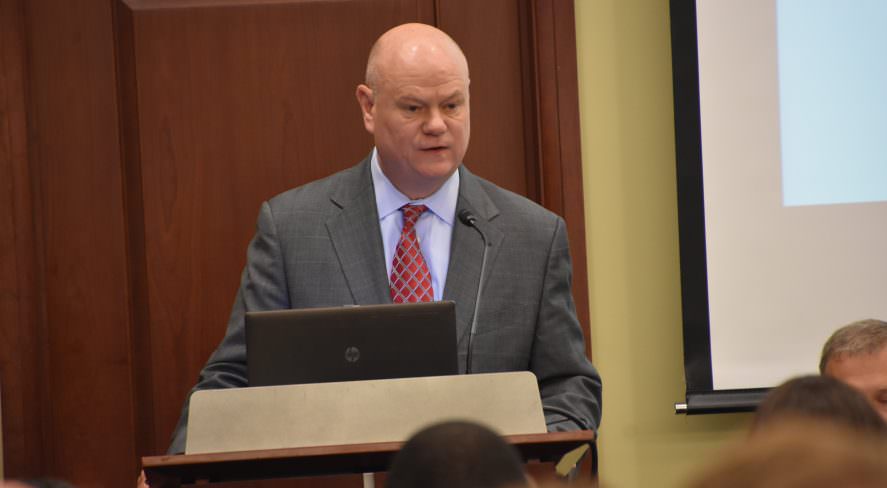Indiana Offered State School Security Model During SIA GovSummit

Tim Eckersley of Allegion discusses school safety at SIA GovSummit.
Officials shared perspective on emergency preparedness measures adopted by the state of Indiana for school security in a panel discussion presented by the Security Industry Association (SIA) and the Congressional School Safety Caucus during the 2017 SIA GovSummit last month.
Introducing speakers at the Summit, Tim Eckersley, senior vice president and president of the Americas region, Allegion hailed his home state as a national leader for the steps it has undertaken in response to Indiana Senate Bill 147, signed into law by then-Gov. Mike Pence in 2016.
Eckersley represents Allegion as a stakeholder in the Partner Alliance for Safer Schools (PASS), an organization co-founded by SIA to prescribe school safety and security guidelines for America’s K-12 schools. Speaking at the panel on June 28, Eckersley called school safety and security “a personal passion” and thanked SIA and Allegion for providing him with a platform to address challenges facing U.S. schools.
“At Allegion, we have decided to put our money, our talent and our efforts where our mouths are, together with parents, educators, policymakers, emergency managers, first responders, and the security industry to help solve deficiencies in the security infrastructure and security technology and life-safety systems in America’s schools,” Eckersley said.
There are roughly 100,000 K-12 public schools across the United States, and the average school facility is about 44 years old, he reported. Regardless of school size or funding, PASS (www.passk12.org) provides guidelines schools can implement to protect their staff and students.
Indiana created a model for other states to follow, Eckersley added. In 2016, the Indiana legislature directed state homeland security department to establish and maintain guidelines for school emergency response systems. The Indiana Department of Homeland Security submitted those initial guidelines to the state legislature on July 1.
The law requires each school district in Indiana to employ a certified school safety specialist, meaning that the state was required to train and certify at least 300 such experts. Last year, Indiana trained and certified about 2,500 specialists as schools went above and beyond the requirement of the law to ensure a certified school safety specialist in each facility.
“In Indiana, the crucial element to a crisis response is a well-trained staff and student body,” explained David Woodward, director of school building physical security and safety, Indiana Department of Education, during the panel.
Indiana is the only state in the United States to require such training, which is provided to a designated educator at no cost. The specialists learn effective drills, protocols and applicable laws, among other things, during five days of training. Every year, specialists return for two additional days of advanced training to address ever-changing threats and best practices to mitigate those threats.
Ninety percent of participants rate the training as very helpful, Woodward said. “Educators are hungry for this training.”
The Indiana Department of Education also reviews school emergency preparedness plans. The department selects 60 school districts a year at random for review. The department is aware that training is key, Woodward said, so plans allow for flexibility to substitute fire drill training, required monthly, with lockdown training or severe weather training up to four times a year.
Indiana Senate Bill 147 also instituted a grants programs for state schools, whether public, private or charter schools. Each school can qualify for a grant up to $50,000 for schools with populations over 1,000 or up to $35,000 for schools with populations under $35,000. The grants total up to $10 million, disbursed over a two-year cycle.
Grant funding from the Secure School Safety Grant provides money for salaries of school resource officers, threat assessments, and equipment, such as access control measures, alarms and communications, said Robert Quinn, Domestic Security Planner, Indiana Department of Homeland Security.
State officials review grant proposals and approve those that make a good case, although officials reserve the right to prescribe specific improvements. For example, if a school requests funding for cameras, but lacks proper locks on doors, officials may direct the school to use grant funding for locks instead.
Schools face a requirement to match the state funds, which has presented a challenge for schools that do not have the money. The Indiana Department of Homeland Security is seeking relief for the match requirement, Quinn said. In addition, the majority of schools have spent their grant funds so far toward salaries for school resource officers. The department is exploring ways to increase capacity among local law enforcement to relieve the demand for school resource officers, thus empowering schools to propose spending more money on equipment and technology.
Indiana Senate Bill 147 tasked the Indiana Department of Homeland Security to develop emergency response system guidelines, which were delivered July 1.
The guidelines outlined recommendations for:
- School emergency operations plans
- Exterior doors (recommended to be locked during school hours at all times)
- Classroom doors (locked doors during class periods)
- Training and drills for students
- Facility hallways (putting teachers in corridors during breaks to interact and remain watchful)
- Common response procedures and common terminology
- Communications plan with first responders
- School resource officer and law enforcement presence
“We stress people over products,” Quinn said, emphasizing a theme to Indiana’s approach to school safety and security.
For more information on SIA GovSummit, visit www.securityindustry.org/summit.
